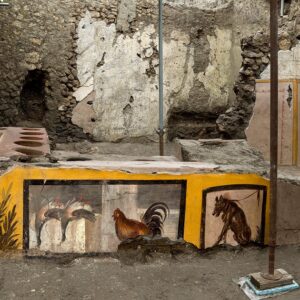Americans like to think that they invented fast food restaurants with McDonald’s but the truth is the Romans had beaten them to it two thousand years ago. As a matter of fact, archeologists in Pompeii have uncovered more than 80 thermopolia, a sort of ancient fast food restaurant where wine and ready-to-eat food, mainly cooked dishes, were sold. The different dishes were kept inside terracotta containers inserted in the circular openings visible on the top of the stone counter and were kept warm by a fire lit underneath.

Among them, a favorite was garum, a fermented fish sauce used to add flavor to most first and second course dishes. The Romans loved this sauce, the quality and cost of which varied according to the types of fish used to make it. The modern day equivalent is the “colatura di alici,” “anchovy drippings,” produced by fermenting anchovies in brine, in the small fishing village of Cetara, on the Amalfi Coast.
The thermopolium presented today had initially been discovered in the spring of 2019 and the excavations continued notwithstanding the government imposed lockdown this year.
The inside of the restaurant is characterized by a huge L-shaped counter decorated with a series of frescoes. The most important one covers the front of the counter and consists of the image of a Nereid (a sea nymph) riding a seahorse in a marine setting, while the shorter side features an illustration which is probably of the shop itself, like a kind of trademark. The last section of the counter to be unearthed revealed several exquisite still life scenes of animals that were likely butchered and sold here. Bone fragments belonging to the same animals were also discovered inside containers embedded in the counter. These held foodstuffs intended for sale, such as the two mallard ducks shown hanging upside down, ready to be cooked and eaten. Other frescoes on the same side of the counter show a rooster and a dog on a leash.

A mocking graffiti inscription is scratched onto the frame which surrounds the painting of the dog: NICIA CINAEDE CACATOR – literally “Nicias (probably a freedman from Greece) Shameless Shitter!” This was probably left by a client who sought to poke fun at the owner, or at someone else who worked in the Thermopolium.
Massimo Osanna, Interim Director General of the Archaeological Park of Pompeii, says the materials represent, “A photograph of that tragic day,” in which the lava sealed the extraordinary colors of the paintings and the elements that allow us to reconstruct food preferences and the habits of the Romans from two thousand years ago.
“For the first time ever, we were able to excavate a complete environment and carry out analyses enabled by modern technology,” said Osanna. The Director General added that, “the materials which have been discovered have been studied by an interdisciplinary team composed of professionals in the fields of physical anthropology, archaeology, archaeobotany, archaeozoology, geology and volcanology. The finds will be further analyzed in the laboratory, and in particular those remains found in the “dolia” (terracotta containers) of the counter that are expected to yield exceptional data about the food that was on sale and what the Romans’ diet was like”.
Researchers found remains of the dishes among the shards of terracotta tableware, including young goat, snails and also, as archeozoologist Chiara Corbino writes in her study, a sort of paella “with the flesh of mammals, birds, fish, and snails, all mixed together.” Likewise, archeobotanist Chiara Comegna reports that the wine was corrected with fava beans to lighten its color and modify its taste, and it was stored in a vase with a small tile on the bottom that was used to separate the beans from the liquid and to avoid pouring the dregs along with the wine.
Thermopolia were located all around the city of Pompeii and clearly were meeting points but mainly places to grab a quick hot bite. The counters of more popular locations – we would say today, the trendy ones – were decorated with frescoes by their owners who had more money to spend to entice their customers.
“Nonetheless, the Roman upper class largely avoided these places. Socializing or eating at thermopolia was considered a lower-class affair”, writes Marco Margaritoff in the website allthatsinteresting.com. Still, Margarithoff adds, “Residents who did frequent them, however, seemed to have enjoyed them just as we today appreciate gathering at bars or pubs. It’s believed that even business deals were regularly struck at these fast food sites.”
In the restaurant, archeologists also found the skeleton of a dog and human remains. “It would seem that the restaurant was closed in all haste and abandoned by the owners,” said Director Massimo Osanna, “but it’s possible that someone, probably the older man, had remained inside and was killed in the first phase of the eruption when the ceiling collapsed on top of him. The second person might have been a thief or a survivor looking for food and trapped by the incandescent vapors while he was still holding the cover of a pot in his hand.”
Archeological excavations began in Pompeii in 1748 and still continue today. Thanks to discoveries like this latest one and the use of new technologies, we’re able to increase our understanding of the way Romans lived two thousand years ago.










